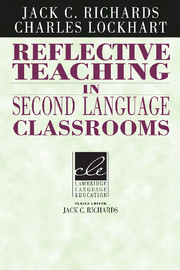Book contents
- Frontmatter
- Contents
- Series editor's preface
- Preface
- Introduction: Teacher development through exploring classroom processes
- 1 Approaches to classroom investigation in teaching
- 2 Exploring teachers' beliefs
- 3 Focus on the learner
- 4 Teacher decision making
- 5 The role of the teacher
- 6 The structure of a language lesson
- 7 Interaction in the second language classroom
- 8 The nature of language learning activities
- 9 Language use in the classroom
- Epilogue
- References
- Index
3 - Focus on the learner
Published online by Cambridge University Press: 29 January 2010
- Frontmatter
- Contents
- Series editor's preface
- Preface
- Introduction: Teacher development through exploring classroom processes
- 1 Approaches to classroom investigation in teaching
- 2 Exploring teachers' beliefs
- 3 Focus on the learner
- 4 Teacher decision making
- 5 The role of the teacher
- 6 The structure of a language lesson
- 7 Interaction in the second language classroom
- 8 The nature of language learning activities
- 9 Language use in the classroom
- Epilogue
- References
- Index
Summary
Language teaching is often discussed from the point of view of the teacher. Elsewhere in this book, some of the ways in which teachers' beliefs, goals, attitudes, and decisions influence how they approach their teaching are examined (see Chapters 2 and 4). However, while learning is the goal of teaching, it is not necessarily the mirror image of teaching. Learners, too, bring to learning their own beliefs, goals, attitudes, and decisions, which in turn influence how they approach their learning. This chapter examines some of the contributions learners bring to learning by exploring learners' beliefs about teaching and learning, the influence of cognitive styles, and the role of learner strategies.
Learner belife systems
Many models of second language acquisition attribute a central role to learner beliefs (e.g., Bialystok 1978; Naiman et al. 1978). Learners' beliefs are influenced by the social context of learning and can influence both their attitude toward the language itself as well as toward language learning in general (Tumposky 1991). Learners' belief systems cover a wide range of issues and can influence learners' motivation to learn, their expectations about language learning, their perceptions about what is easy or difficult about a language, as well as the kind of learning strategies they favor.
Beliefs about the nature of English Learners often have very focused perceptions about which aspects of English they find difficult, and about the status of English in comparison to other languages. This is seen in the following statements made by ESL learners in Japan: English is much more difficult to learn than other languages.
Information
- Type
- Chapter
- Information
- Reflective Teaching in Second Language Classrooms , pp. 52 - 77Publisher: Cambridge University PressPrint publication year: 1994
